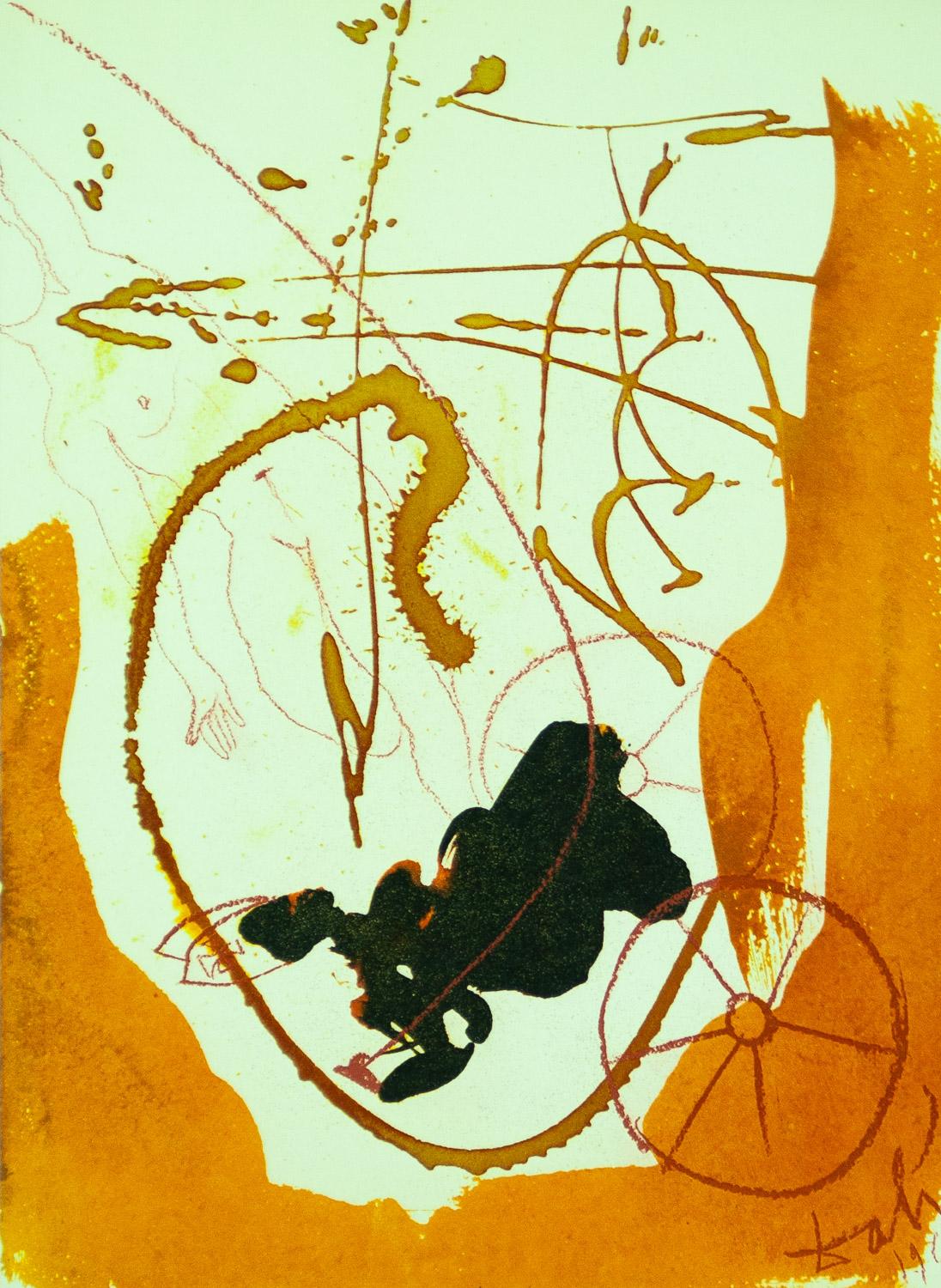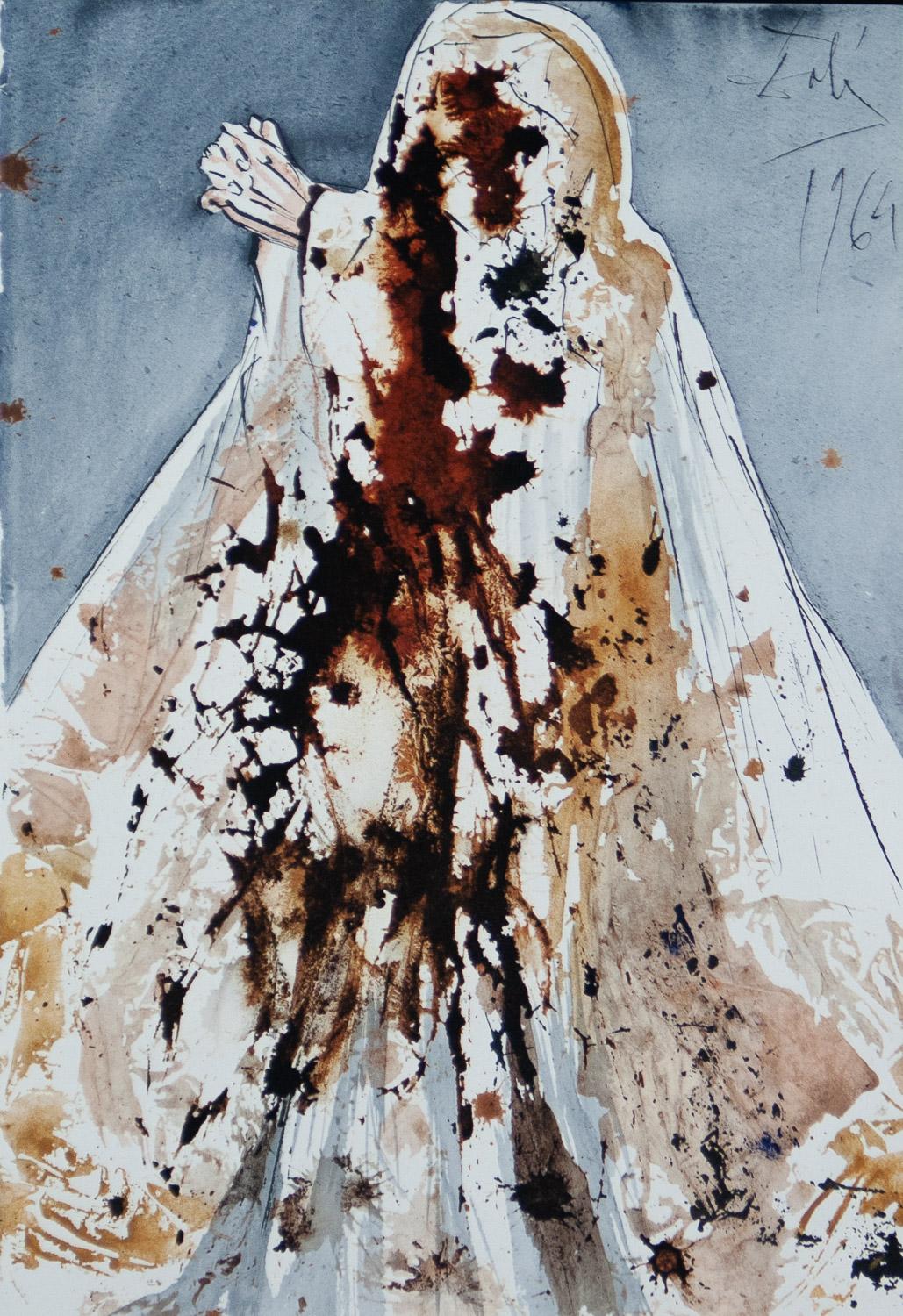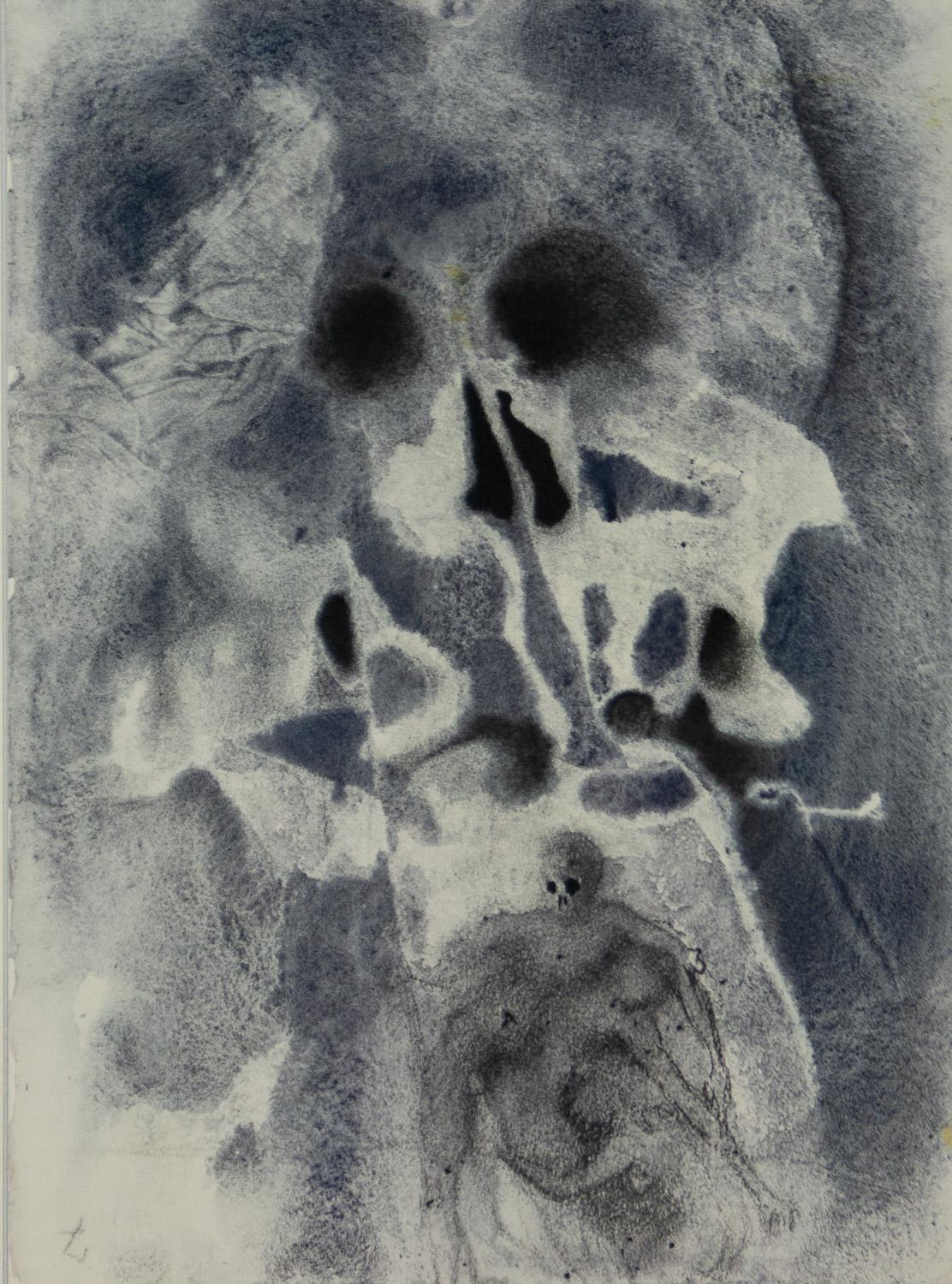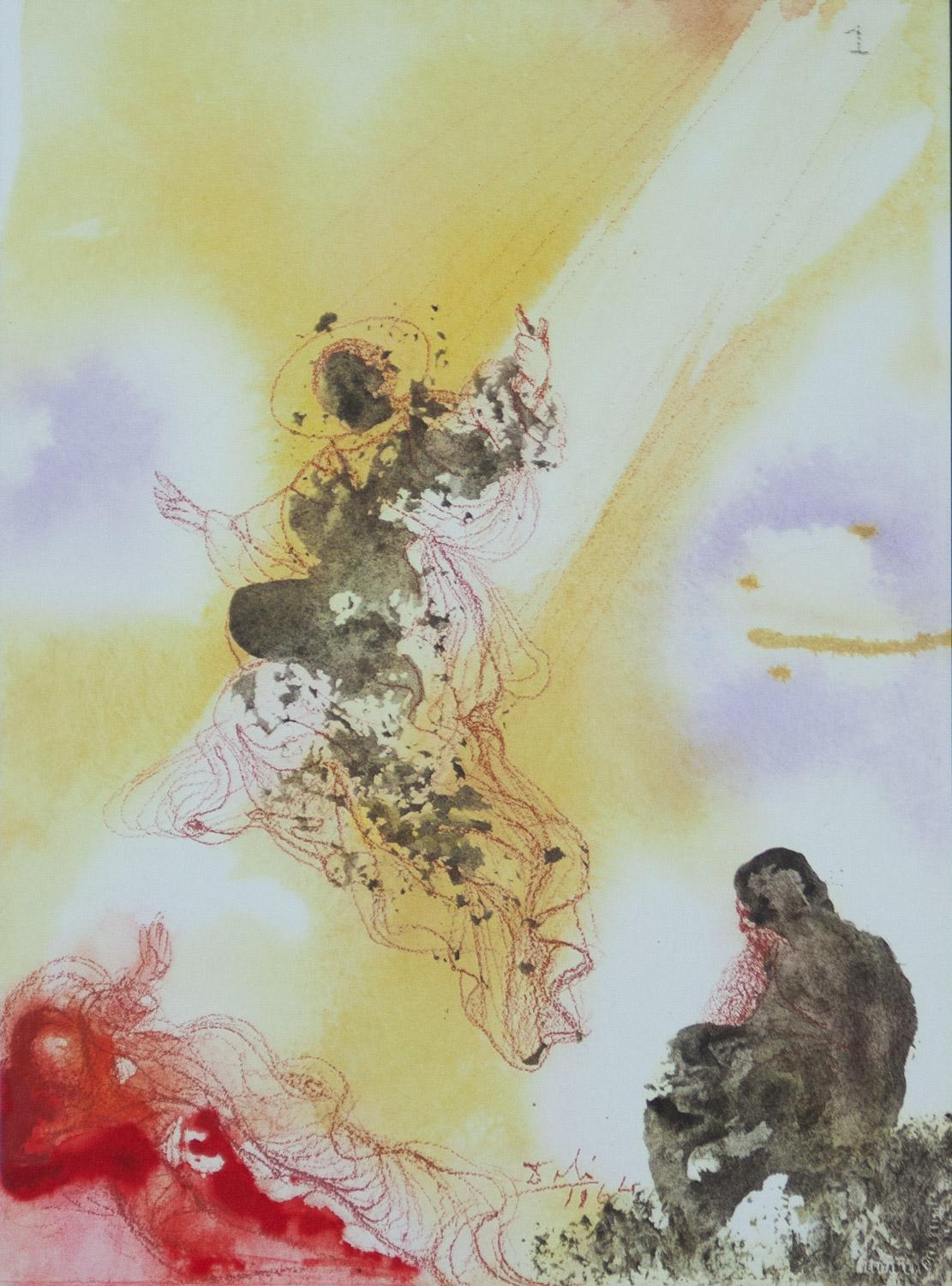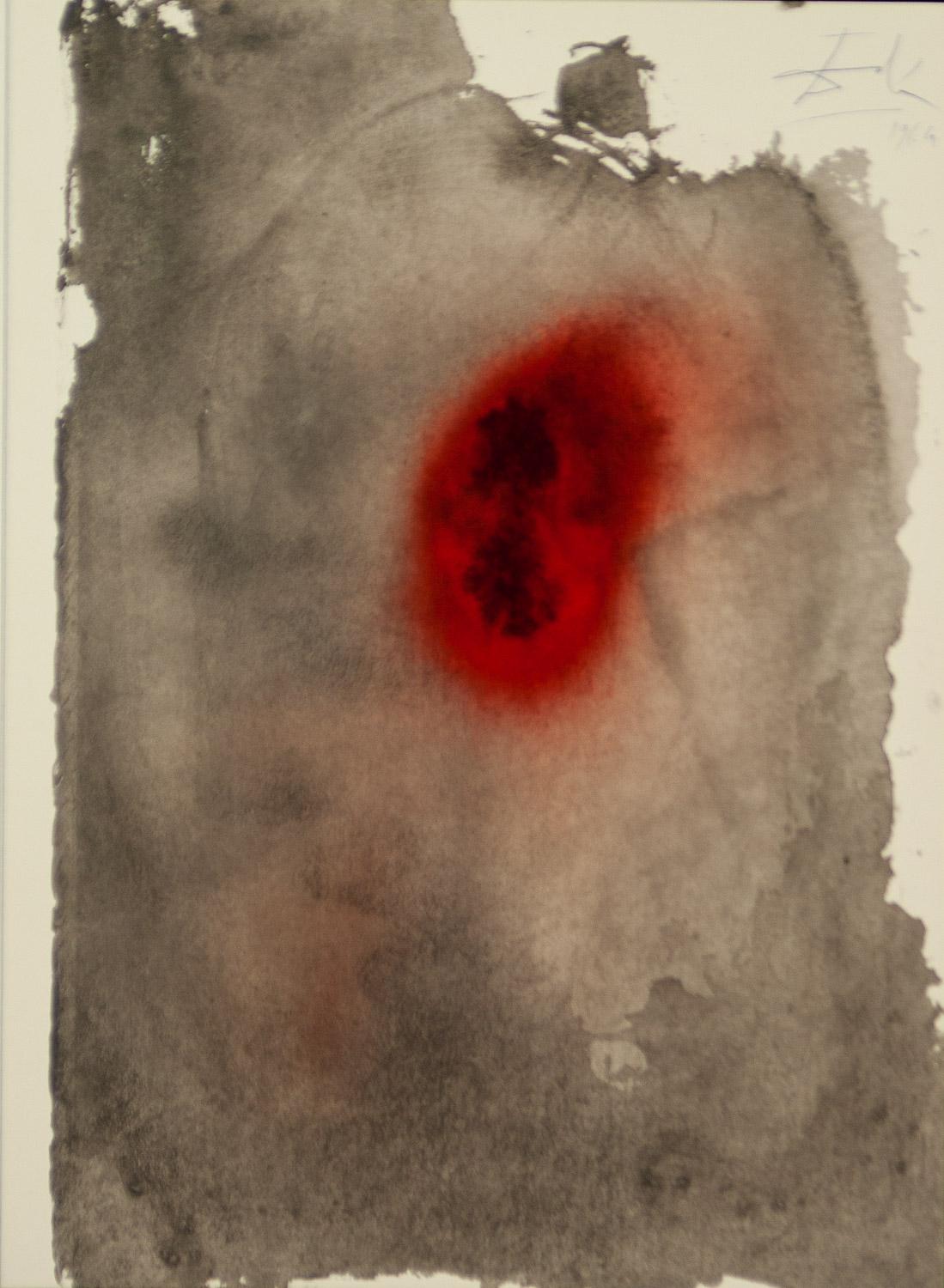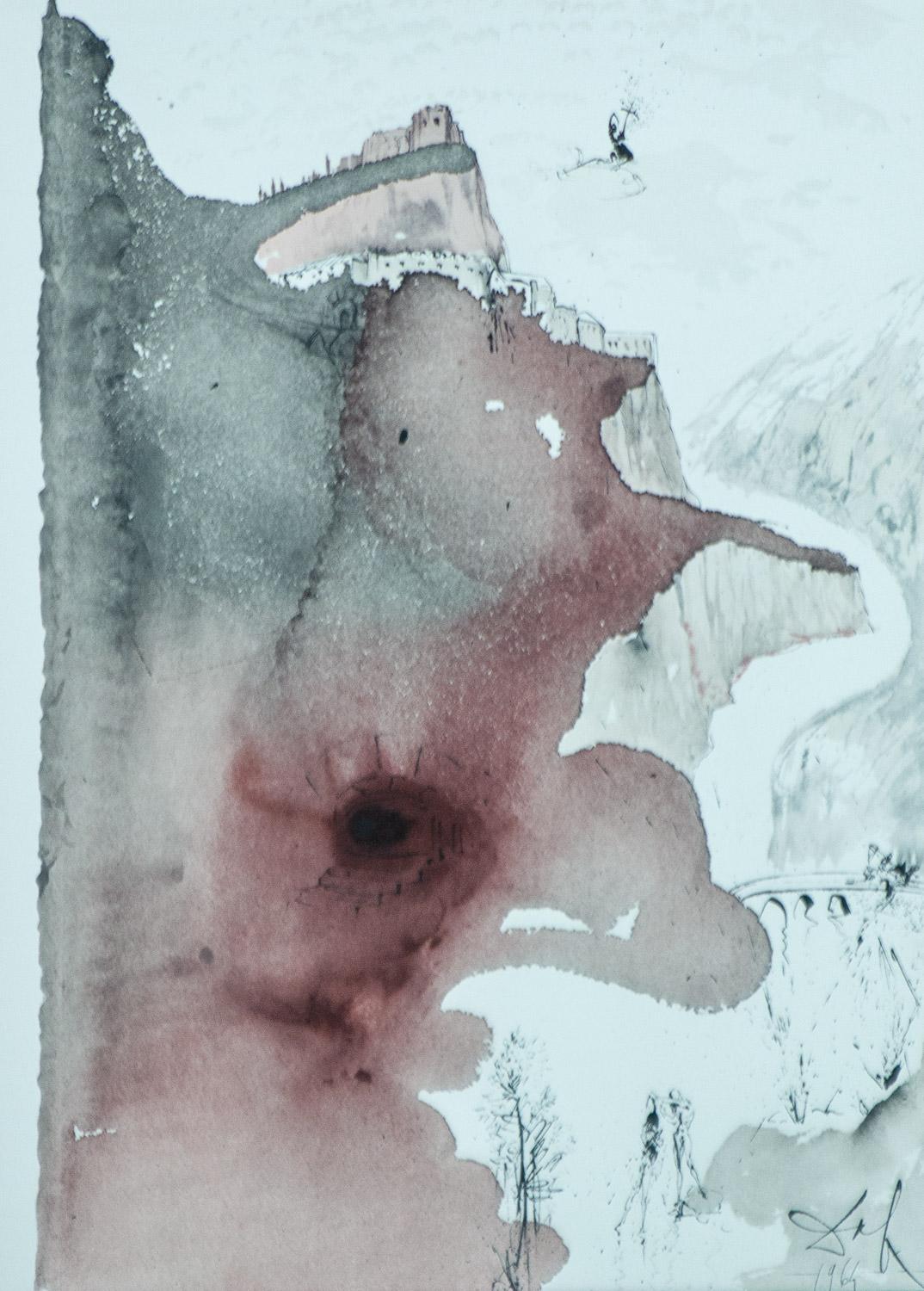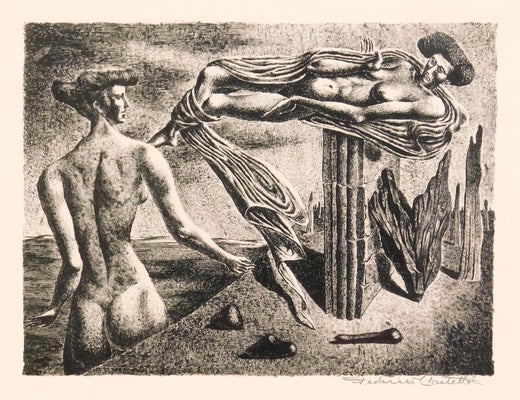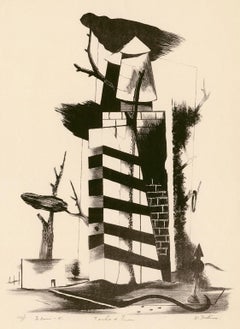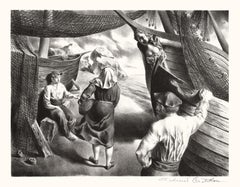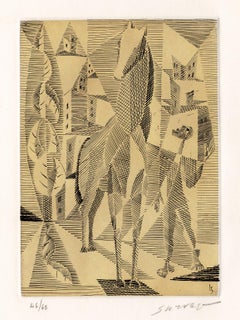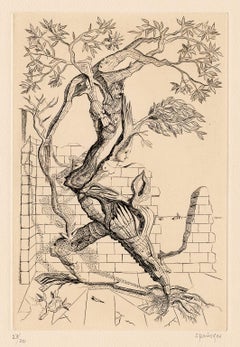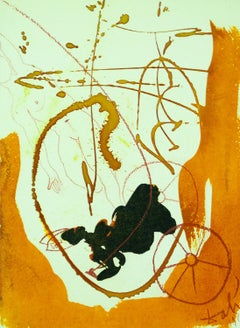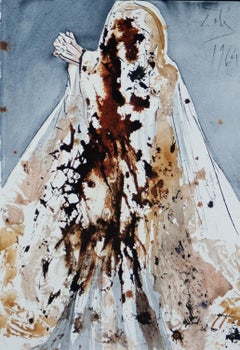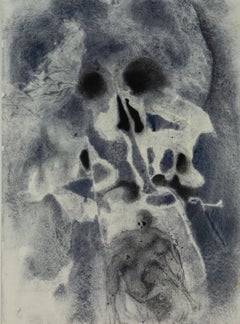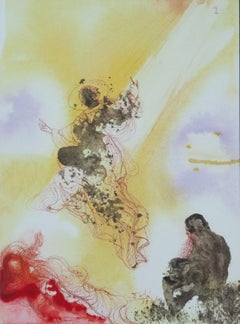Articles similaires à 'Body and Soul' — Mid-20th Century Surrealism
Vous voulez plus d'images ou de vidéos ?
Demander au vendeur plus d'images ou de vidéos
1 sur 6
Federico Castellon'Body and Soul' — Mid-20th Century Surrealism1938
1938
À propos de cet article
Federico Castellon, 'Body and Soul', 1938, lithograph, edition 30, Freundlich 3. Signed in pencil. Signed in the stone, lower left. A fine, richly-inked, atmospheric impression on cream, wove paper, with full margins ( 13/4 to 2 3/8 inches), in excellent condition. Matted to museum standards, unframed. Scarce.
Image size 11 1/4 x 15 1/8 inches (286 x 384 mm); sheet size 15 3/4 x 20 5/16 inches (400 x 516 mm).
In this striking, surrealist composition, Castellon alludes to man's age-old concerns of earthly impermanence and mystical transcendence.
An impression of this work is held in the permanent collection of the Philadelphia Museum of Art.
ABOUT THE ARTIST
“The art of Federico Castellon has a baffling yet fascinating quality. ...The artist sojourns in a world of free imagination, untrammeled by a logic of literal fact. He brings report of strange realms, uncharted seas of symbolism in the unconscious. The emblems and images which he brings back to us are clothed with the most minute and convincing verisimilitude and kind of superrealism."
—Carl Zigrosser, Federico Castellon, His Graphic Works, 1936-1971, August L. Freundlich, Syracuse University, New York, 1978.
Federico Castellon was only seven years old when his family immigrated from Almería, Spain, to Brooklyn, New York. He began sketching at an early age, as imaginative drawings provided an outlet for expression, which was particularly useful for Castellon, given his limited English at the time. Although his teachers recognized his talents as a draftsman, he remained largely self-taught. As a teenager, Castellon regularly visited museums in New York to study the Old Masters. After gaining mastery of realistic rendering, he became inspired by the work of the great modern artists, including Pablo Picasso, Georges Rouault, Diego Rivera, and Giorgio de Chirico.
Shortly after graduating from Erasmus High School, he completed an arts and sciences mural for the school. The mural, informed by his interest in European modernism, attracted critical attention and was exhibited in New York at Raymond and Raymond Galleries before being permanently installed in the school. At about this time, Castellon was introduced to Diego Rivera at a lecture the artist gave on his murals for Rockefeller Center. The older artist took an interest in the young man’s work and brought Castellon’s drawings to the attention of Carl Zigrosser, the Director of the Weyhe Gallery in New York, who gave the eighteen-year-old Castellon his first solo exhibition.
In 1934, with Rivera’s help, Castellon was awarded a four-year fellowship sponsored by the Spanish Government to study art and travel throughout Europe. During this time, he studied painting and printmaking, exhibiting his work at the Casa de Velázquez in Madrid and in the 1935 Paris Exhibition of Spanish and American Artists, which featured Pablo Picasso, Juan Gris, and Joan Miró.
In 1937, Castellon returned to New York and made his first lithograph with master lithographer George Miller. He exhibited in the Whitney Museum Annual in 1937 and 1938. In 1940, the Pennsylvania Academy of the Fine Arts awarded him the Eyre Medal for his lithograph Rendez-vous in a Landscape. He also exhibited at the Weyhe Gallery and the Art Institute of Chicago. In the same year, he received the first of two Guggenheim fellowships. In 1942, he participated in an exhibition at Carnegie Institute.
Although his formal education ended with high school, Castellon remained an avid reader with interests in psychology and philosophy. He became a United States citizen in 1943, and throughout the 1940s and 1950s, his work was informed by his travels abroad, including to China with the U.S. Army, Italy on his second Guggenheim fellowship, and Paris and Madrid, where he relocated his family for a brief period during the late 1950s. He also began teaching during this time, holding successive positions at Columbia University, Pratt Institute, the New School for Social Research, the National Academy of Design, and Queens College. He also took on commissions from American periodicals, most notably LIFE magazine.
In 1947, Castellon exhibited at the Philadelphia Art Alliance and again at the Carnegie Institute. In 1949, he was awarded a National Institute Arts and Letters Grant. He was elected to the National Academy and held solo exhibitions in Paris, Bombay, and New York at Associated American Artists.
Life magazine commissioned Castellon to create a series of paintings illustrating “Memorable Victories in the Fight of Justice” in 1951. He spent 1954 traveling with solo exhibitions of his paintings and graphics throughout South America. Life magazine published his work again in 1955, ‘56, and ‘57. From 1958 to 1960, he began working in sculpture, and from 1961 to 1963, he traveled with his family to France, Spain, and Italy. In 1963, he executed a series of lithographs at the renowned L’Atelier de Jacques Desjobert, Paris, and was elected to the National Academy of Design. Returning to the U.S. in 1964, Castellon held a solo exhibition at Terry Dintenfass Gallery in New York, exhibited at the New York World’s Fair, and received awards from the Philadelphia Print Club and the Society of American Graphic Artists. In 1966, he held a solo exhibition of graphic work at Associated American Artists, and in 1968, he was elected a Member of the National Institute of Arts and Letters. In 1971, the last year of his life, he exhibited at the Biennale Internationale de l'Estampe d'Épinal in Paris.
Castellón's prints and drawings from the 1930s represent some of the earliest examples of surrealism created in the United States. These highly original works predate his travels abroad and the Museum of Modern Art’s seminal exhibition, 'Fantastic Art, Dada, and Surrealism,' in July 1937.
Castellon's work is held in numerous museum collections in America and abroad, including the Amon Carter Museum of American Art, Art Institute of Chicago, Brooklyn Museum, The Butler Institute of American Art, Carnegie Museum of Art, Cleveland Museum of Art, Denver Art Museum, Instituto de Estudios Almerienses (Spain), The Isreal Museum (Jerusalem), Library of Congress, Los Angeles County Museum of Art, Museo Nacional Centro de Arte Reina Sofia (Spain), New Orleans Museum of Art, Pennsylvania Academy of the Fine Arts, Princeton University Art Museum, Metropolitan Museum of Art, Museum of Modern Art, Portland Art Museum, Saint Louis Art Museum, Smithsonian American Art Museum, Springfield Museum of Art, Washington County Museum of Fine Arts, and the Whitney Museum of American Art.
- Créateur:Federico Castellon (1914-1971, Américain)
- Année de création:1938
- Dimensions:Hauteur : 28,58 cm (11,25 po)Largeur : 35,56 cm (14 po)
- Support:
- Mouvement et style:
- Période:
- État:
- Adresse de la galerie:Myrtle Beach, SC
- Numéro de référence:Vendeur : 1032351stDibs : LU532316357312
Federico Castellon
Federico Castellón (1914-1971) était un artiste hispano-américain connu pour son style distinctif mêlant surréalisme et réalisme. Né sur l'île d'Almeria, en Espagne, il s'est installé aux États-Unis avec sa famille à l'âge de sept ans. Son talent artistique s'est manifesté dès son plus jeune âge et il a obtenu une bourse pour étudier à la New York School of Fine and Applied Art alors qu'il n'avait que 15 ans. L'œuvre de Castellón se caractérise par une qualité onirique, incorporant souvent des éléments fantastiques et un sens aigu de la narration. Son exposition précoce aux cultures espagnole et américaine a profondément influencé sa vision artistique, mêlant le surréalisme européen au réalisme américain pour créer un langage visuel unique. Il était particulièrement réputé pour ses lithographies, ses gravures et ses illustrations. Ses illustrations du "Masque de la mort rouge" d'Edgar Allan Poe et d'autres œuvres littéraires sont très appréciées pour leurs détails complexes et leur imagerie obsédante. Outre ses travaux de gravure et d'illustration, Castellón était également un peintre et un muraliste de talent. Ses peintures présentent souvent des scènes surréalistes et oniriques mettant l'accent sur les figures humaines, et ses peintures murales sont réputées pour leur composition dynamique et leur riche symbolisme. Tout au long de sa carrière, Castellón a reçu de nombreux prix et distinctions, et ses œuvres ont été largement exposées aux États-Unis et en Europe. Son héritage continue d'influencer les artistes et est reconnu dans le monde de l'art pour son mélange unique de surréalisme et de réalisme, ainsi que pour sa qualité narrative profonde qui parle de la condition humaine.
À propos du vendeur
5,0
Vendeur reconnu
Ces vendeurs prestigieux sont des leaders du secteur. Ils représentent le summum en matière de qualité et de design.
Vendeur Platine
Vendeurs premium dont la note est supérieure à 4,7 et le délai de réponse de 24 heures maximum
Établi en 1995
Vendeur 1stDibs depuis 2016
301 ventes sur 1stDibs
Temps de réponse habituel : 1 heure
Associations
International Fine Print Dealers Association
- ExpéditionRecherche du devis...Expédition depuis : Myrtle Beach, SC
- Politique des retours
Certaines parties de cette page ont été traduites automatiquement. 1stDibs ne garantit pas l'exactitude des traductions. L'anglais est la langue par défaut de ce site web.
Garantie d'authenticité
Bien qu'il soit peu probable que la situation se présente, dans le cas où vous rencontreriez un problème d'authenticité d'un article, contactez-nous dans un délai d'un an pour obtenir un remboursement intégral. DétailsGarantie de remboursement
Si votre article n'est pas conforme à la description, est endommagé pendant le transport ou ne vous est pas livré, contactez-nous sous 7 jours pour obtenir un remboursement intégral. DétailsAnnulation sous 24 heures
Vous disposez d'un délai de 24 heures pour annuler votre achat sans motif.Des vendeurs professionnels agréés
Nos vendeurs de renommée mondiale doivent respecter des normes strictes en matière de service et de qualité, afin de préserver l'intégrité de nos fiches produit.Garantie d'alignement des prix
Si vous constatez qu'un autre vendeur a mis en vente le même article à un prix inférieur sur un autre site, nous nous alignerons sur ce prix.Livraison en toute confiance à l'international
Notre réseau de transporteurs de premier ordre propose des options d'expédition spécialisées dans le monde entier, y compris des livraisons personnalisées.Plus d'articles de ce vendeur
Tout afficherChars et arbres - Le surréalisme américain du milieu du siècle dernier
Karl Eugene Fortess, "Tanks & Trees", lithographie, c. 1940, édition 100. Signé, titré et numéroté "100/P" au crayon. Inscrit " For Usui - K. " dans la marge inférieure gauche. Une b...
Catégorie
années 1940, Surréalisme, Estampes - Figuratif
Matériaux
Lithographie
By the Arks" - Le surréalisme du milieu du 20e siècle
Par Federico Castellon
Federico Castellon, "By the Arks", 1941, lithographie, édition 250, Freundlich 10D. Signé au crayon. Signé dans la pierre, en bas à gauche. Une belle impression atmosphérique sur pap...
Catégorie
années 1940, Surréalisme, Estampes - Figuratif
Matériaux
Lithographie
Le Cheval - Cubisme du milieu du siècle
Par Léopold Survage
Léopold Survage, 'Le Cheval', gravure en couleur, édition 60, 1953. Signé et numéroté "46/60" au crayon. Initialisé dans la plaque, en bas à droite. Une superbe impression, richement...
Catégorie
années 1950, Surréalisme, Estampes - Figuratif
Matériaux
Eau-forte
Arbre-Homme - Le surréalisme européen du milieu du siècle dernier
Par Ferdinand Springer
Ferdinand Springer, "Arbre-Homme", gravure, 1945, édition 23. Signé et numéroté "23/20" au crayon.
Une belle impression, richement encrée, sur un papier vélin lourd et chamois, la f...
Catégorie
années 1940, Surréalisme, Estampes - Figuratif
Matériaux
Gravure
Encircled' - Mid-Century Surrealism, Atelier 17
Ian Hugo, "Encircled", gravure, 1946, édition 50. Signé, daté, titré et numéroté "5/50" au crayon. Avec le cachet aveugle 'madeleine-claude jobrack EDITIONS', dans la marge inférieu...
Catégorie
années 1940, Surréalisme, Estampes - Figuratif
Matériaux
Gravure
Femme de la forêt" - Surréalisme du milieu du siècle, Atelier 17
Ian Hugo, "Femme de la forêt", gravure, 1945, édition 50. Signé, daté, titré et numéroté "5/50" au crayon. Avec le cachet aveugle 'madeleine-claude jobrack EDITIONS', dans la marge ...
Catégorie
années 1940, Surréalisme, Estampes - Figuratif
Matériaux
Gravure
Suggestions
Into the Grave of Elish from Biblia Sacra (Into the Grave of Elish) par Salvador Dali
Par Salvador Dalí
Into the Grave of Elish est une lithographie colorée d'après l'original gouaché sur papier chiffon épais de la Biblia Sacra Suite en cinq volumes de Salvador Dali, publiée à Rom...
Catégorie
années 1960, Surréalisme, Estampes - Abstrait
Matériaux
Lithographie
Élevés de Lazarus de Biblia Sacra par Salvador Dali
Par Salvador Dalí
Lever de Lazarus de Salvador Dali tirée de Biblia Sacra est une lithographie colorée tirée de l'original gouaché sur papier chiffon épais de la suite Biblia Sacra en cinq volu...
Catégorie
années 1960, Surréalisme, Estampes - Abstrait
Matériaux
Lithographie
Sepultus de Losias en motif Mausoleo de Bibla Sacra de Salvador Dali
Par Salvador Dalí
Losias Sepultus in Mausoleo Patrum ( Josias enterré dans le mausolée de son père ) est une lithographie colorée d'après la gouache originale sur papier chiffon épais de la ...
Catégorie
années 1960, Surréalisme, Estampes - Abstrait
Matériaux
Lithographie
Saint Raphael de la Biblia Sacra par Salvador Dali
Par Salvador Dalí
Saint Raphael est une lithographie colorée d'après la gouache originale sur papier chiffon épais, tirée de la Biblia Sacra Suite en cinq volumes de Salvador Dali, publiée à Rom...
Catégorie
années 1960, Surréalisme, Estampes - Figuratif
Matériaux
Lithographie
Il a crié et a respiré son dernier de Biblia Sacra Salvador Dali
Par Salvador Dalí
Il a poussé un grand cri et a rendu son dernier soupir est une lithographie colorée d'après la gouache originale sur papier chiffon épais, tirée de la Biblia Sacra Suite en ci...
Catégorie
années 1960, Surréalisme, Estampes - Abstrait
Matériaux
Lithographie
Et il a été baptisé de Biblia Sacra par Salvador Dali
Par Salvador Dalí
And He Was Baptised est une lithographie colorée d'après la gouache originale sur papier chiffon épais, tirée de la Biblia Sacra Suite en cinq volumes de Salvador Dali, publiée à...
Catégorie
années 1960, Surréalisme, Estampes - Figuratif
Matériaux
Lithographie
